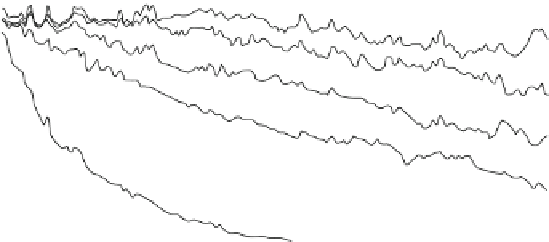Geoscience Reference
In-Depth Information
(a)
6
5
10.9 m
4
9.2 m
3
7.2 m
5.3 m
2
3.3 m
1
0
Nov.
Dec.
Jan.
Feb.
Mar.
Apr.
(b)
14
12
3.3 m
10
5.3 m
8
6
7.2 m
4
9.2 m
2
10.9 m
0
Nov.
Dec.
Jan.
Feb.
Mar.
Apr.
Fig. 7.18
Temperature (
a
) and dissolved oxygen concentration (
b
) in the central part of Lake
Vendyurskoe, Russian Karelia, during the winter 2010
-
2011 at several depths (Redrawn from
Terzhevik et al. 2010)
The life activity of bacterial plankton is the main consumer of DO and it is strongly
dependent on the water temperature (Boylen and Brock 1973; Welch et al. 1976).
However, it is normally assumed that in winter conditions the in
uence of temperature on
the bacterial activity is not large and oxygen depletion depends only on the concentration
of organic matter in the water column (Golosov et al. 2006). The biochemical oxygen
demand of lake water (BOD) and lake sediment (SOD) are the main factors governing the
oxygen depletion in ice-covered lakes. It is believed that SOD makes the major contri-
bution (Greenbank 1945; Hargrave 1969), though no quantitative relation between SOD
and BOD has been established (Ellis and Stefan 1989). Both BOD and SOD are strongly
affected by physical conditions: vertical temperature strati
fl
cation, near-bottom currents,
and the heat release from sediments. SOD, de
ned as the rate at which DO is consumed
from the water column due to the decomposition of organic matter in the bottom sedi-
ments, is controlled by mass transport and/or biochemical reactions in the upper sediment
and in the diffusive boundary layer above (Higashino et al. 2004).




































Search WWH ::

Custom Search